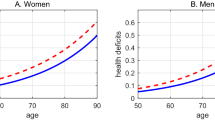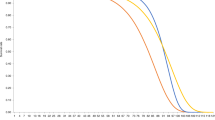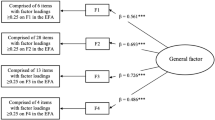Abstract
Human senescence has been delayed by a decade. This finding, documented in 1994 and bolstered since, is a fundamental discovery about the biology of human ageing, and one with profound implications for individuals, society and the economy. Remarkably, the rate of deterioration with age seems to be constant across individuals and over time: it seems that death is being delayed because people are reaching old age in better health. Research by demographers, epidemiologists and other biomedical researchers suggests that further progress is likely to be made in advancing the frontier of survival — and healthy survival — to even greater ages.
This is a preview of subscription content, access via your institution
Access options
Subscribe to this journal
Receive 51 print issues and online access
$199.00 per year
only $3.90 per issue
Buy this article
- Purchase on Springer Link
- Instant access to full article PDF
Prices may be subject to local taxes which are calculated during checkout




Similar content being viewed by others
References
Jeune, B. Living longer—but better? Aging Clin. Exp. Res. 14, 72–92 (2002). This engaging account, with 238 references, summarizes ideas and theories about longevity from Genesis and the Sumerian legend of Gilgamesh to the present.
Aristotle . in The Complete Works of Aristotle: The Revised Oxford Translation (ed. Barnes, J.) 740–744 (Princeton Univ. Press, 1984).
Galen . in Hygiene: De Sanitate Tuenda Vol. 1, Ch. 2 (Thomas, 1951).
Bacon, R. in The Code of Health and Longevity (ed. Sinclair, J.) (Constable, 1806).
Cornaro, L. The Art of Living Long (Springer, 2005).
Hamilton, W. D. The moulding of senescence by natural selection. J. Theor. Biol. 12, 12–45 (1966).
Gruenberg, E. M. The failures of success. Milbank Q. 55, 3–24 (1977).
Fries, J. F. Aging, natural death, and the compression of morbidity. N. Engl. J. Med. 303, 130–135 (1980).
Vaupel, J. W. & Gowan, A. E. Passage to Methuselah: some demographic consequences of continued progress against mortality. Am. J. Public Health 76, 430–433 (1986).
Guralnik, J. M., Yanagishita, M. & Schneider, E. L. Projecting the older population of the United States: lessons from the past and prospects for the future. Milbank Q. 66, 283–308 (1988).
Olshansky, S. J., Carnes, B. A. & Cassel, C. In search of Methuselah: estimating the upper limits to human longevity. Science 250, 634–640 (1990).
Manton, K. G., Stallard, E. & Tolley, H. D. Limits to human life expectancy: evidence, prospects, and implications. Popul. Dev. Rev. 17, 603–637 (1991).
Hayflick, L. Biological aging is no longer an unsolved problem. Ann. NY Acad. Sci. 1100, 1–13 (2007).
Vaupel, J. W. & Lundström, H. in Studies in the Economics of Aging (ed. Wise, D. A.) 79–104 (Univ. Chicago Press, 1994). The discovery of the postponement of mortality, as demonstrated by four complementary analyses of a then-new Swedish data set, was first reported in this book chapter.
Kannisto, V., Lauritsen, J., Thatcher, A. R. & Vaupel, J. W. Reductions in mortality at advanced ages: several decades of evidence from 27 countries. Popul. Dev. Rev. 20, 793–810 (1994).
Kannisto, V. Development of Oldest-Old Mortality, 1950–1990: Evidence from 28 Developed Countries (Odense Univ. Press, 1994).
Kannisto, V. The Advancing Frontier of Survival: Life Tables for Old Age (Odense Univ. Press, 1996).
Vaupel, J. W. The remarkable improvements in survival at older ages. Phil. Trans. R. Soc. Lond. B. 352, 1799–1804 (1997).
Vaupel, J. W. et al. Biodemographic trajectories of longevity. Science 280, 855–860 (1998).
Tuljakurpar, S., Li, N. & Boe, C. A universal pattern of mortality decline in the G7 countries. Nature 405, 789–792 (2000).
Wilmoth, J. R., Deegan, L. J., Lundström, H. & Horiuchi, S. Increase of maximum life-span in Sweden, 1861–1999. Science 289, 2366–2368 (2000).
Kannisto, V. Mode and dispersion of the length of life. Population 13, 159–171 (2001).
Oeppen, J. & Vaupel, J. W. Broken limits to life expectancy. Science 296, 1029–1031 (2002). This article shows that life expectancy has increased by more than two years per decade since 1840 in the countries with highest life expectancies and that there is no imminent limit to further increases.
Cheung, S. L. K. & Robine, J.-M. Increase in common longevity and the compression of mortality: the case of Japan. Popul. Stud. (Camb.) 61, 85–97 (2007).
Canudas- Romo, V. The modal age at death and the shifting mortality hypothesis. Demogr. Res. 19, 1179–1204 (2008).
Rau, R., Soroko, E., Jasilionis, D. & Vaupel, J. W. Continued reductions in mortality at advanced ages. Popul. Dev. Rev. 34, 747–768 (2008).
Bongaarts, J. Trends in senescent life expectancy. Popul. Stud. (Camb.) 63, 203–213 (2009).
Christensen, K., Doblhammer, G., Rau, R. & Vaupel, J. W. Ageing populations: the challenges ahead. Lancet 374, 1196–1208 (2009). This paper concludes, on the basis of a thorough review of research on mortality, morbidity and disability, that both survival and health are improving at higher ages.
Freedman, V. A. et al. Resolving inconsistencies in trends in old-age disability: report from a technical working group. Demography 41, 417–441 (2004).
Christensen, K., McGue, M., Petersen, I., Jeune, B. & Vaupel, J. W. Exceptional longevity does not result in excessive levels of disability. Proc. Natl Acad. Sci. USA 105, 13274–13279 (2008).
Engberg, H., Christensen, K., Andersen-Ranberg, K., Vaupel, J. W. & Jeune, B. Improving activities of daily living in Danish centenarians — but only in women: a comparative study of two birth cohorts born in 1895 and 1905. J. Gerontol. A 63, 1186–1192 (2008).
Jeune, B. & Brønnum-Hansen, H. Trends in health expectancy at age 65 for various health indicators, 1987–2005, Denmark. Eur. J. Ageing 5, 279–285 (2008).
Jagger, C. et al. Inequalities in healthy life years in the 25 countries of the European Union in 2005: a cross-national meta-regression analysis. Lancet 372, 2124–2131 (2008).
Cutler, D. M. & Wise, D. A. (eds) Health at Older Ages: The Causes and Consequences of Declining Disability among the Elderly (Univ. Chicago Press, 2008).
Parker, M. G., Schön, P., Lagergren, M. & Thorslund, M. Functional ability in the elderly Swedish population from 1980 to 2005. Eur. J. Ageing 5, 299–309 (2008).
Robine, J.-M. & Saito, Y. in Frontiers of Japanese Demography (ed. Goldstein, J. R.) (Springer, in the press).
Sierra, F., Hadley, E., Suzman, R. & Hodes, R. Prospects for life span extension. Annu. Rev. Med. 60, 457–469 (2009). This comprehensive overview of an extensive literature provides a balanced account of possible advances in research on health and survival at higher ages and of potential challenges.
Lee, R. D. & Goldstein, J. R. in Life Span: Evolutionary, Ecological, and Demographic Perspectives (eds Carey, J. R. & Tuljapurkar, S.) 183–207 (Population Council, 2003).
Vaupel, J. W. & Loichinger, E. Redistributing work in aging Europe. Science 312, 1911–1913 (2006).
Holmes, O. W. in Over the Teacups 181 (Houghton Mifflin, 1890).
McGue, M., Vaupel, J. W., Holm, N. V. & Harvald, B. Longevity is moderately heritable in a sample of Danish twins born 1870–1880. J. Gerontol. A 48, B237–B244 (1993).
Herskind, A. M. et al. Untangling genetic influences on smoking, body mass index and longevity: a multivariate study of 2464 Danish twins followed for 28 years. Hum. Genet. 98, 467–475 (1996).
Perls, T. T. et al. Life-long sustained mortality advantage of siblings of centenarians. Proc. Natl Acad. Sci. USA 99, 8442–8447 (2002).
Hjelmborg, J. vB. et al. Genetic influences on human lifespan and longevity. Hum. Genet. 119, 312–321 (2006).
Christensen, K., Johnson, T. E. & Vaupel, J. W. The quest for genetic determinants of human longevity: challenges and insights. Nature Rev. Genet. 7, 436–448 (2006).
Riley, J. C. Rising Life Expectancy: A Global History (Cambridge Univ. Press, 2001).
Gerdes, L. U., Jeune, B., Andersen-Ranberg, K., Nybo, H. & Vaupel, J. W. Estimation of apolipoprotein E genotype-specific relative mortality risks from the distribution of genotypes in centenarians and middle-aged men: apolipoprotein E gene is a 'frailty gene', not a 'longevity gene'. Genet. Epidemiol. 19, 202–210 (2000).
Ewbank, D. C. Differences in the association between apolipoprotein E genotype and mortality across populations. J. Gerontol. A 62, 899–907 (2007).
Curtsinger, J. W., Fukui, H. H., Townsend, D. R. & Vaupel, J. W. Demography of genotypes: failure of the limited life-span paradigm in Drosophila melanogaster. Science 258, 461–463 (1992).
Tissenbaum, H. A. & Johnson, T. E. in Molecular Biology of Aging (eds Guarente, L., Partridge, L. & Wallace, D. C.) 153–183 (Cold Spring Harbor Laboratory Press, 2008).
Johnson, T. E. Increased life-span of age-1 mutants in Caenorhabditis elegans and lower Gompertz rate of aging. Science 249, 908–912 (1990).
Butler, R. N. et al. New model for health promotion and disease prevention for the 21st century. Br. Med. J. 337, 149–150 (2008).
Farrelly, C. Has the time come to take on time itself? Br. Med. J. 337, 148–149 (2008).
Finch, C. E. Longevity, Senescence and the Genome (Univ. Chicago Press, 1990).
Rose, M. R. Evolutionary Biology of Aging (Oxford Univ. Press, 1994).
Wachter, K. W. & Finch, C. E. (eds) Between Zeus & the Salmon (US Natl Acad. Press, 1997).
Kirkwood, T. B. L. Time of Our Lives: The Science of Human Aging (Oxford Univ. Press, 1999).
Kirkwood, T. B. L. & Austad, S. N. Why do we age? Nature 408, 233–238 (2000).
Kirkwood, T. B. L. Understanding the odd science of aging. Cell 120, 437–443 (2005).
Vaupel, J. W., Baudisch, A., Dölling, M., Roach, D. A. & Gampe, J. The case for negative senescence. Theor. Popul. Biol. 65, 339–351 (2004).
Baudisch, A. Hamilton's indicators of the force of selection. Proc. Natl Acad. Sci. USA 102, 8263–8268 (2005).
Baudisch, A. Inevitable Aging? Contributions to Evolutionary-Demographic Theory (Springer, 2008). This pioneering work uses models based on evolutionary theory and demographic concepts to demonstrate that senescence is not inevitable for all species.
Vaupel, J. W. & Jeune, B. in Exceptional Longevity: From Prehistory to the Present (eds Jeune, B. & Vaupel, J. W.) 109–116 (Odense Univ. Press, 1995).
Mair, W., Goymer, P., Pletcher, S. D. & Partridge, L. Demography of dietary restriction and death in Drosophila. Science 301, 1731–1733 (2003).
Sohal, R. S. & Weindurch, R. Oxidative stress, caloric restriction, and aging. Science 273, 59–63 (1996).
Perls, T. T., Silver, M. H. & Lauerman, J. F. Living to 100 (Perseus, 1999).
Carey, J. R., Liedo, P., Orozco, D. & Vaupel, J. W. Slowing of mortality rates at older ages in large medfly cohorts. Science 258, 457–461 (1992).
Doblhammer, G. & Oeppen, J. Reproduction and longevity among the British peerage. Proc. R. Soc. Lond. B 270, 1541–1547 (2003).
Oksuzyan, A., Juel, K., Vaupel, J. W. & Christensen, K. Men: good health and high mortality; sex differences in health and aging. Aging Clin. Exp. Res. 20, 91–102 (2008).
Austad, S. Why women live longer than men. Gend. Med. 3, 79–92 (2006).
Bonduriansky, R., Maklakov, A., Zajitschek, F. & Brooks, R. Sexual selection, sexual conflict and the evolution of ageing and life span. Funct. Ecol. 22, 443–453 (2008).
Olsen, T. S., Dehlendorff, C. & Andersen, K. K. The female stroke survival advantage: relation to age. Neuroepidemiology 32, 47–52 (2009).
Maier, H., Gampe, J., Jeune, B., Robine, J.-M. & Vaupel, J. W. (eds) Supercentenarians (Springer, in the press).
Jeune, B. & Vaupel, J. W. (eds) Validation of Exceptional Longevity (Odense Univ. Press, 1999).
Preston, S. H. The changing relation between mortality and level of economic development. Popul. Stud. (Camb.) 29, 231–248 (1975).
Rogers, R. G., Hummer, R. A. & Nam, C. B. Living and Dying in the USA: Behavioral, Health, and Social Differentials of Adult Mortality (Academic, 2000).
Crimmins, E. M. & Preston, S. H. (eds) Divergent Trends in Life Expectancy (National Research Council, in the press).
Barker, D. J. P., Bergmann, R. L. & Ogra, P. L. (eds) The Window of Opportunity: Pre-Pregnancy to 24 Months of Age (Karger, 2008).
Doblhammer, G. The Late Life Legacy of Very Early Life (Springer, 2004).
Moore, S. E., Cole, T. J., Poskitt, E. M. E. & Sonko, B. J. Season of birth predicts mortality in rural Gambia. Nature 388, 434–435 (1997).
Kannisto, V., Christensen, K. & Vaupel, J. W. No increased mortality in later life for cohorts born during famine. Am. J. Epidemiol. 145, 987–994 (1997).
Christensen, K., Vaupel, J. W., Holm, N. V. & Yashin, A. I. Mortality among twins after age 6: fetal origins hypothesis versus twin method. Br. Med. J. 310, 432–436 (1995).
Wang, H. & Preston, S. H. Forecasting United States mortality using cohort smoking histories. Proc. Natl Acad. Sci. USA 106, 393–398 (2009).
Vaupel, J. W., Wang, Z., Andreev, K. F. & Yashin, A. I. Population Data at a Glance: Shaded Contour Maps of Demographic Surfaces over Age and Time 22; 39; 52; 54; 59–63 (Odense Univ. Press, 1997).
Vaupel, J. W., Carey, J. R. & Christensen, K. It's never too late. Science 301, 1679–1681 (2003).
Edwards, R. D. & Tuljapurkar, S. Inequality in life spans and a new perspective on mortality convergence across industrialized countries. Popul. Dev. Rev. 31, 645–675 (2005).
Wilmoth, J. R. The future of human longevity: a demographer's perspective. Science 280, 395–397 (1998).
Alho, J. M. & Spencer, B. D. Statistical Demography and Forecasting (Springer, 2005).
Haaga, J. G. et al. What's next for the demography of aging? Popul. Dev. Rev. 35, 323–365 (2009).
Carey, J. R. & Vaupel, J. W. in Handbook of Population (eds Poston, D. L. Jr & Micklin, M.) 625–658 (Springer, 2005).
Carey, J. R. & Tuljapurkar, S. (eds) Life Span: Evolutionary, Ecological, and Demographic Perspectives (Population Council, 2003).
Chu, C. Y. C., Chien, H.-K . & Lee, R. D. Explaining the optimality of U-shaped age-specific mortality. Theor. Popul. Biol. 73, 171–180 (2008).
Steinsaltz, D. R., Evans, S. N. & Wachter, K. W. A generalized model of mutation-selection balance with applications to aging. Adv. Appl. Math. 35, 16–33 (2005).
Dobzhansky, T. Nothing in biology makes sense except in the light of evolution. Am. Biol. Teach. 35, 125–129 (1973).
Preston, S. H., Heuveline, P. & Guillot, M. Demography: Measuring and Modeling Population Processes (Blackwell, 2000).
Caselli, G., Vallin, J. & Wunsch, G. Demography: Analysis and Synthesis Vols 1–4 (Academic, 2006).
Vaupel, J. W., Manton, K. G. & Stallard, E. The impact of heterogeneity in individual frailty on the dynamics of mortality. Demography 16, 439–454 (1979).
Finkelstein, M. & Esaulova, V. Asymptotic behavior of a general class of mixture failure rates. Adv. Appl. Probab. 38, 244–262 (2006).
Steinsaltz, D. R. & Wachter, K. W. Understanding mortality rate deceleration and heterogeneity. Math. Popul. Stud. 13, 19–37 (2006).
Vaupel, J. W. & Yashin, A. I. Heterogeneity's ruses. Am. Statist. 39, 176–185 (1985).
Acknowledgements
I thank Z. Zhang, A. Baudisch, K. Christensen, G. Doblhammer, J. Haaga, B. Jeune, S. Leek, R. Rau, S. Scherneck, R. Suzman and N. Vaupel. My research is supported in part by the Max Planck Society and by the US National Institute on Aging (NIA P01-08761).
Author information
Authors and Affiliations
Additional information
Reprints and permissions information is available at http://www.nature.com/reprints. The author declares no competing financial interests. Correspondence should be addressed to the author (jwv@demogr.mpg.de).
Rights and permissions
About this article
Cite this article
Vaupel, J. Biodemography of human ageing. Nature 464, 536–542 (2010). https://doi.org/10.1038/nature08984
Published:
Issue Date:
DOI: https://doi.org/10.1038/nature08984
This article is cited by
-
Technologies for frailty, comorbidity, and multimorbidity in older adults: a systematic review of research designs
BMC Medical Research Methodology (2023)
-
The impact of stomach cancer mortality on life expectancy at birth: a decomposition analysis in east Asian countries from 1990 to 2019
China Population and Development Studies (2023)
-
Combining remaining life expectancy and time to death as a measure of old-age dependency related to health care needs
International Journal of Health Economics and Management (2023)
-
Retirement and Epigenetic age Acceleration Among Older U.S. Adults
Adaptive Human Behavior and Physiology (2023)
-
Comparing the associations between muscle strength, walking speed, and mortality in community-dwelling older adults of two birth cohorts born 28 years apart
GeroScience (2023)
Comments
By submitting a comment you agree to abide by our Terms and Community Guidelines. If you find something abusive or that does not comply with our terms or guidelines please flag it as inappropriate.



